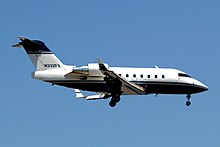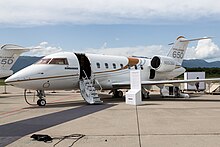Bombardier Challenger 600
| Bombardier Challenger 600 | |
|---|---|
 Canadian Forces Challenger 601 |
|
| Type: | Business jet |
| Design country: | |
| Manufacturer: | |
| First flight: |
November 8, 1978 |
| Production time: |
In series production since 1978 |
The Bombardier Challenger 600 is a family of business aircraft designed by William P. Lear under the name LearStar 600 for use in the short and medium-haul range. The design of the LearStar 600 was purchased in April 1976 by the Canadian aircraft construction company Canadair , which implemented the concept under the name Challenger 600 . Even after the takeover of Canadair by Bombardier , the project was continued and new variants were added.
variants
Challenger 600
The Canadair Challenger 600 was the original version. Two were used as drive turbofans ALF-502L of Avco Lycoming whose jet engine division now part of Honeywell International is. The thrust was 33.6 kN per engine.
More than a year before the maiden flight, the project had swallowed up over two million Canadian dollars, and the Canadian parliament approved a highly controversial state aid for Canadair. At the same time, Bill Lear also left the development team because he did not agree with the changed configuration of the aircraft. He found its shape less elegant than that of the original LearStar and called it "Fat Albert".
Challenger 601
After the CL600, the Challenger 601-1A saw the biggest change in the drive. Here the vulnerable Avco Lycoming ALF 502L engines were replaced by more modern and more powerful General Electric CF-34 -3A. This increased the maximum take-off boost by around 20 percent, and fuel consumption also fell significantly. The engine is based on the General Electric TF34, already proven on the A-10 of the US Air Force with the same arrangement on the fuselage . Further innovations of the CL-601 include the introduction of winglets , a more modern EFIS cockpit from Honeywell and the introduction of an additional tank as standard in the outermost tail of the aircraft (which also extended it). This increased the maximum take-off weight and range. This so-called “tail tank” was previously available as a retrofit kit from a supplier.
Challenger 604
The Challenger 604 is a further development of the Challenger 600 or 601 for up to 19 passengers . By installing additional tanks in the rear, the range was increased by 819 km compared to the CL601-3R (compared to the CL600 even 2272 km). This made the Challenger a long-haul aircraft. The most significant changes to the last CL601 version (CL601-3R) were made with the installation of a glass cockpit from Rockwell Collins. In addition, the aircraft received a significantly reinforced landing gear with larger tires, which also made it possible to enlarge and improve the brakes. The engines have been slightly increased in performance compared to the CL601, which is particularly noticeable in better take-off and climb performance. The thrust of the new CF-34-3B is limited to 38.8 kN in normal operation, but including the so-called Automatic Power Reserve (APR) it can be increased to up to 41 kN.
Challenger 605
The Bombardier Challenger 605 has some innovations inside, while the aerodynamics and engines have remained unchanged. The improvements include, in particular, larger windows and newly developed avionics. Externally, the 605 can be distinguished from the 604 by the modified rear cone and the higher-lying windows.
Challenger 650
The Bombardier Challenger 650 is the latest version, which was shown for the first time at EBACE in Geneva in 2015 . She has more modern CF-34 engines, modernized avionics and the cabin has been redesigned. The Swiss Air Rescue will replace its old Challenger 604 from 2018.
Military operator
In addition to numerous civil companies, several armed forces also use aircraft from the Challenger 600 series as liaison and VIP aircraft for high-ranking military and politicians.
-
 Royal Australian Air Force - The No. The 34th Squadron of the Australian Air Force isstationedat Canberra Airport and uses three Challenger 604s to complement their two Boeing Business Jets.
Royal Australian Air Force - The No. The 34th Squadron of the Australian Air Force isstationedat Canberra Airport and uses three Challenger 604s to complement their two Boeing Business Jets.
-
 Royal Canadian Air Force - The Canadian Air Force uses the Challenger as the CC-144. The aircraft arestationedin Trenton, Ontario , at the 412th Transport Squadron. The previous Challenger squadron of the Canadian Air Forces was the 434th transport squadron.
Royal Canadian Air Force - The Canadian Air Force uses the Challenger as the CC-144. The aircraft arestationedin Trenton, Ontario , at the 412th Transport Squadron. The previous Challenger squadron of the Canadian Air Forces was the 434th transport squadron.
-
 Vzdušné síly Armády České republiky - In the Czech Republic's VIP fleet, theCl-601-3A version of the Challengeris used in addition to the ACJ319 ; these aircraft arestationedin Prague -Kbely and assigned to the 241st transport squadron.
Vzdušné síly Armády České republiky - In the Czech Republic's VIP fleet, theCl-601-3A version of the Challengeris used in addition to the ACJ319 ; these aircraft arestationedin Prague -Kbely and assigned to the 241st transport squadron.
-
 Flyvevåbnet - Four Challenger 604sstationed at Aalborg Airport in the 721st Squadron.
Flyvevåbnet - Four Challenger 604sstationed at Aalborg Airport in the 721st Squadron.
-
 Turk. MIT secret service - A Challenger with the license plate TC-KLE was used, among other things, to abduct opponents of the regime.
Turk. MIT secret service - A Challenger with the license plate TC-KLE was used, among other things, to abduct opponents of the regime.
-
 Swiss Air Force - (T-751 and T-752). Takeover of two Challenger 604s (HB-JRB and HB-JRC) from REGA in 2019.
Swiss Air Force - (T-751 and T-752). Takeover of two Challenger 604s (HB-JRB and HB-JRC) from REGA in 2019.
- Former operator
-
 German Air Force - The Challenger 601 variant was used in Germany by the Federal Ministry of Defense from 1986 to 2011. The Challenger mainly used the flight readiness for the political and parliamentary area. Transport, courier and liaison flights were also carried outfor the Federal Ministry of Defense . MedEvac flightswere alsopossible withthree upgrade kits. The Bundeswehr owned seven machines of this type with the license plates 12 + 01 to 12 + 07. The model was replaced in 2011 by the Bombardier Global 5000 , which has a substantially greater range of around 9,500 km and can use slightly shorter runways.
German Air Force - The Challenger 601 variant was used in Germany by the Federal Ministry of Defense from 1986 to 2011. The Challenger mainly used the flight readiness for the political and parliamentary area. Transport, courier and liaison flights were also carried outfor the Federal Ministry of Defense . MedEvac flightswere alsopossible withthree upgrade kits. The Bundeswehr owned seven machines of this type with the license plates 12 + 01 to 12 + 07. The model was replaced in 2011 by the Bombardier Global 5000 , which has a substantially greater range of around 9,500 km and can use slightly shorter runways.
Technical specifications
| Parameter | Challenger 600 | Challenger 601 | Challenger 604/605 | Challenger 650 | |
|---|---|---|---|---|---|
| length | 20.85 m | ||||
| span | 18.85 m | 19.61 m | |||
| height | 6.3 m | ||||
| Wing area | 41.8 m² | 45.71 m² | 45.4 m² | ||
| Hull diameter | 2.69 m | ||||
| Cabin length | 8.66 m | 7.80 m | |||
| Cabin width | 2.19 m (floor) / 2.49 m (maximum) | 2.41 m | |||
| Cabin height | 1.85 m | 1.83 m | |||
| Cabin volume | 32.56 m³ | ||||
| Range | 5,925 km | 6,235 km | 7,427 km | 7,408 km | |
| Top speed | Mach 0.855 | ||||
| Max. Cruising speed | Mach 0.82 | ||||
| usual cruising speed | Do 0.80 | ||||
| Long distance travel speed | Mach 0.74 | ||||
| Service ceiling | 12,500 m | ||||
| Max. Takeoff mass | 18,325 kg | 19,550 kg | 21,863 kg | ||
| Takeoff route | ? | ? | 1,780 m | 1,720 m | |
| Landing route | ? | ? | 846 m | 732 m | |
| crew | 2 | ||||
| Passengers | depending on the seating, usually up to 12; up to 19 | ||||
| Engines | Avco Lycoming ALF-502L | General Electric CF-34-3A | General Electric CF34-3B | GE CF34-3B MTO | |
| Thrust | 33.6 kN | 40.7 kN | 38.84 kN (41 kN APR) | 9,220 lbf (41 kN) | |
Incidents
On January 7, 2017, a Challenger 604 of MHS Aviation on the flight from the Maldives to Munich got caught in the wake of an Airbus A380-800 of the Emirates , which was on its way from Dubai to Australia (flight Emirates EK 412) over the Arabian Sea. and passed the Challenger at the minimum required altitude of 1000 feet. The Challenger rotated several times around its own axis, quickly lost altitude and suffered massive damage to the on-board electronics, an engine and the interior. The pilots were able to regain control of the severely damaged machine and make an emergency landing in Muscat . Two seriously injured passengers had to be treated in the hospital. The Challenger was written off as a total loss.
See also
Web links
- Challenger 600 website
- EASA-TCDS-A.023 (PDF; 206 kB) - Type certification of the CL-600 series
- Technical data of the Challenger 605 at FlugRevue
- The Challenger 600 at Airliners.net (engl.)
- The Challenger 601 and 604 at Airliners.net (engl.)
Individual evidence
- ↑ Air-Britain Aviation World (English), March 2020, p. 6.
- ↑ Air-Britain Aviation World (English), March 2020, p. 7.
- ↑ Bombardier shows Challenger 650 at EBACE , accessed on June 17, 2015
- ↑ Tages-Anzeiger : Rega buys jets for 130 million francs , accessed on June 17, 2015
- ↑ CL-601-3A - Challenger. In: Army.cz. Ministry of Defense of the Czech Republic, accessed January 3, 2019 .
- ^ Søren Augustensen: Denmark's Challengers . In: Air International . No. 4 . Key Publishing, April 2015, ISSN 0306-5634 , p. 82-85 .
- ^ The Royal Danish Air Force. In: forsvaret.dk. Flyvevåbnet, accessed March 20, 2015 .
- ↑ https://correctiv.org/top-stories/2018/12/06/black-sites/
- ↑ Federal Council gives the green light for the purchase of Rega second-hand jets. In: Blick.ch. February 14, 2018, accessed January 3, 2019 .
- ↑ Marco Evers: Expert opinion: Airbus air turbulence almost crashed another aircraft. In: Spiegel Online . May 16, 2017. Retrieved June 9, 2018 .


